Chicago is well known for a bunch of things—among them a baseball team that does not win, fabulous pizza1, and uninsulated masonry buildings. The Windy City2 does not want to be known for its uninsulated masonry building problem. Truth be told, this is not just a Chicago problem, but a Boston problem and a New York problem and a Philadelphia problem and a Detroit problem and a Montreal problem.3
That these buildings are durable is not in dispute. That these buildings do not burn is not in dispute. Not burning is a feature. That cow thing in 18714 is still on peoples minds today. The new masonry buildings we build are not an issue. We know how to insulate those. The question is what do we do with the old ones? Knock them down? Why do that? They have “good bones.” Whatever happened to “adaptive reuse” and all that greenie stuff?
So now what? Fix them up? They are horrible thermally. They have to be insulated. There are only two choices—insulate them on the inside or insulate them on the outside. Once again I demonstrate my keen eye for the obvious. The physics argues for the outside. And when you do it from the outside you don’t give up interior space. However, “historic look” and the preservationists argue for the inside. But not all uninsulated Chicago masonry buildings are historic. And some of them are down right ugly. Many could do with an “insulated face lift”…a deep retrofit from the outside…a Chicago deep-dish retrofit. So that is where we are going to go. We already did the inside insulation thing way back when (BSI-047: Thick As A Brick).
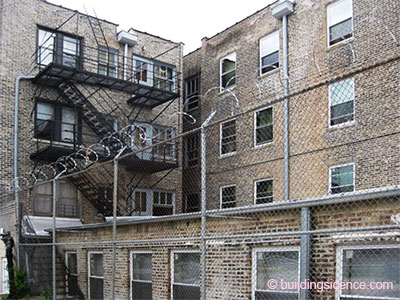
Photograph 1: Jumbo-Sized—Uninsulated masonry building
These buildings can come “jumbo” sized (Photograph 1) or “house” sized (Photograph 2). Regardless of size, they can be addressed the same way. Coat the exterior of the masonry with a fluid applied water control layer and air control layer. Install rather robust wood furring (2x4’s “on the flat”) directly to the masonry. Then insulate over the entire assembly with rigid insulation and install additional furring for cladding attachment. Finish the entire thing off with new cladding (Figure 1). Easy. We can retrofit an uninsulated masonry wall “with good bones” and—presto—get “a perfect wall” out of the deal.
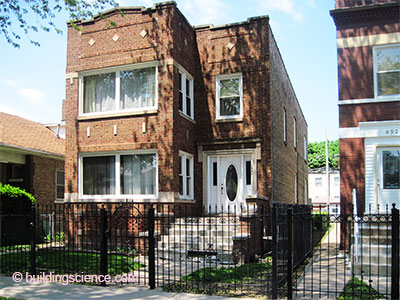
Photograph 2: House-sized—Uninsulated masonry building
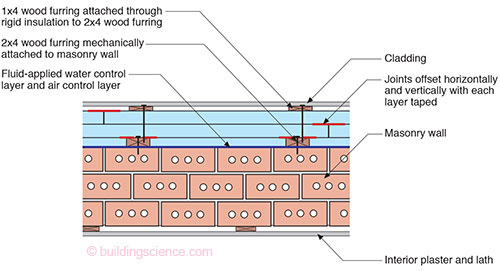
Figure 1: Perfect Wall Retrofit— Coat the exterior of the masonry with a fluid applied water control layer and air control layer. Install rather robust wood furring (2x4’s “on the flat”) directly to the masonry. Then insulate over the entire assembly with rigid insulation and install additional furring for cladding attachment. Finish the entire thing off with new cladding.
The “secret” trick is the 2x4 wood furring “on the flat”—once you attach that, everything else attaches to that, and it is easy sailing. And it is not a big deal to attach wood furring directly to masonry or to concrete—we know how to do that (Photograph 3).
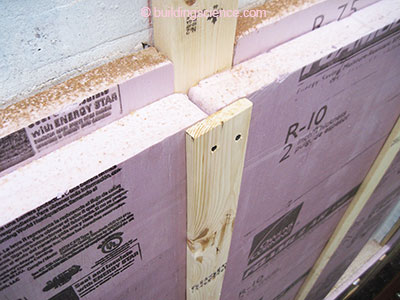
Photograph 3: 2x4 wood furring “on the flat” – once you attach that everything else attaches to that and it is easy sailing. And it is not a big deal to attach wood furring directly to masonry or to concrete – we know how to do that.
What can be easier? Not so fast. Some rigid insulations burn. Some do not, but are not so rigid. Remember this is Chicago. Fire is a big deal. What complicates things even more is that sometimes the buildings are very close together. Getting a “rated” wall is not easy. No one has “burned” these types of configurations. You are going to have to throw yourself at the mercy of “the authority having jurisdiction.” Relax. Not all “authorities” are crazy. In fact, most are darn right helpful. But it does help if an alderman gives them a call…especially in Chicago.
We got real help from everyone on this issue…manufacturers included. All of the walls passed the “don’t burn” “smell test.” The rigid foams all have a flame-spread index of 25 or less, and a smoke-developed index of 450 or less, and they are sandwiched between masonry and non-combustible claddings. If you want to go “all out,” use mineral fiber insulation and metal hat channels (Figure 2). Fluffy rocks covered with cement board held in place with steel anchors and metal channels installed over a masonry wall will please even the most persnickety Chicago fireman.
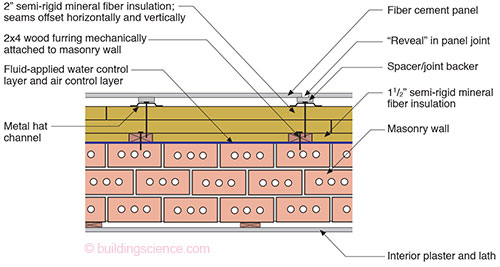
Figure 2: Non-Combustible Perfect Wall Retrofit—If you want to go “all out” use mineral fiber insulation and metal hat channels. Fluffy rocks covered with cement board held in place with steel anchors and metal channels installed over a masonry wall will please even the most persnickety Chicago fireman.
Believe it or not, the biggest code issue is a “set back” issue. When we do this retrofit, we are adding several inches to the outside of buildings and intruding on lot lines. The good news is that common sense wins the day. Giving up a couple inches to get a building or a house or a duplex a new lease on life—a comfortable energy efficient lease on life—is not a difficult sell…if the right calls to the right people are made at the right time…check out Photograph 4. Nobody misses the 6 inches between these two houses. This issue is going to come up again and again and again. Bylaws are going to have to be “massaged.” I thought I would never say this, but New York City has got it on the ball and does not count the exterior insulation in the “set back” dimension.5
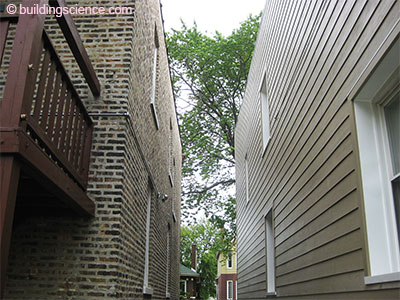
Photograph 4: Set Back” Issue—We are adding several inches to the outside of buildings and intruding on lot lines. Nobody misses the 6 inches between these two houses. Bylaws are going to have to be “massaged.” I thought I would never say this, but New York City has got it on the ball and does not count the exterior insulation in the “set back” dimension.
The jumbo-sized buildings have their own special problems…which we have all learned to call opportunities. Parapets and existing flat roofs that intersect the parapets provide interesting opportunities. You need to wrap the parapet with insulation—or get rid of it. I always make the “get rid of it” argument first. There is no good reason to have one anymore (BSI-050: Parapets—Where Roofs Meet Walls). Good luck with the “getting rid of it” argument. Folks seem to have an unnatural attraction to their parapets. Whatever. When you wrap the darn thing, it is a really good idea to insulate over the top of the existing roof and add a new membrane (Figure 3). And don’t forget to slope the parapet cap to the interior. And don’t forget the drip edges. And don’t forget the counter flashing. And don’t forget the air control layer continuity (Photograph 5 and Photograph 6).
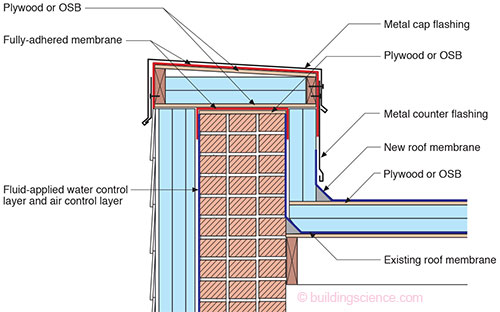
Figure 3: You need to wrap the parapet with insulation—or get rid of it. When you wrap the darn thing it is a really good idea to insulate over the top of the existing roof and add a new membrane
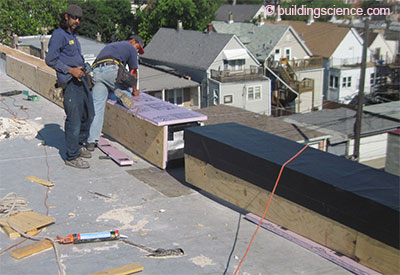
Photograph 5: Parapet Insulation—Don’t forget to slope the parapet to the interior.
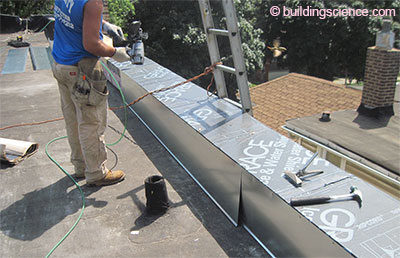
Photograph 6: Parapet Water Proofing—Don’t forget the drip edges. And don’t forget the counter flashing.
With the jumbo-sized buildings, you just start on one side and work your way around. First the fluid applied water control layer, and air control layer, and the 2x4 wood furring (Photograph 7). Then you layer in the rigid insulation (Photograph 8). Then the cladding. In this case, fiber cement panels (Photograph 9, Photograph 10 and Photograph 11).
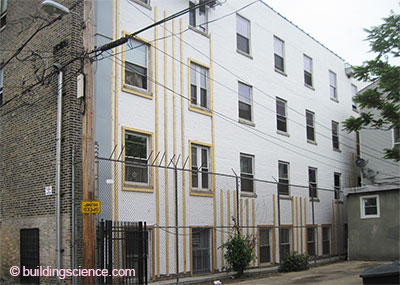
Photograph 7: Jumbo Sequencing—With the jumbo sized buildings you just start on one side and work your way around. First the fluid applied water control layer and air control layer and the 2x4 wood furring.
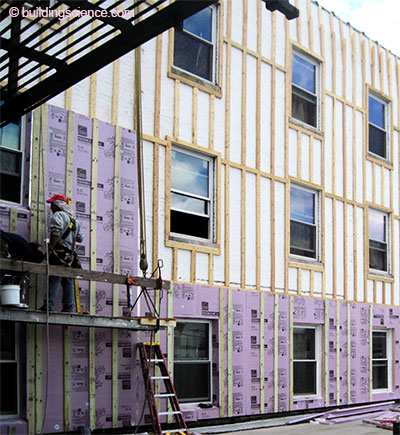
Photograph 8: Next Step—Add the rigid insulation. Layer it between the furring and then over the entire kit and caboodle in continuous layers.
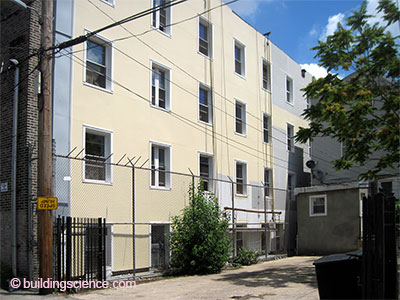
Photograph 9: Fiber cement Panels—Fireproof and pretty robust.
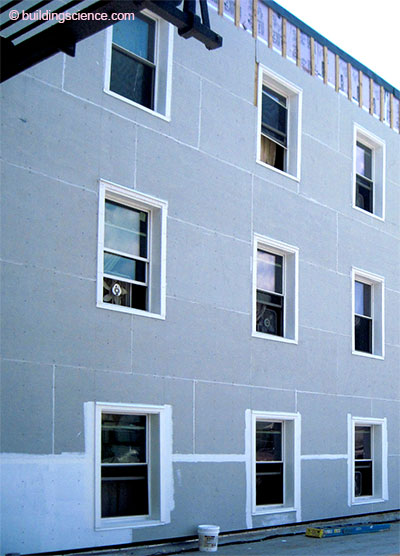
Photograph 10: More Fiber cement Panels—Note the “innie” windows. I don’t always win.
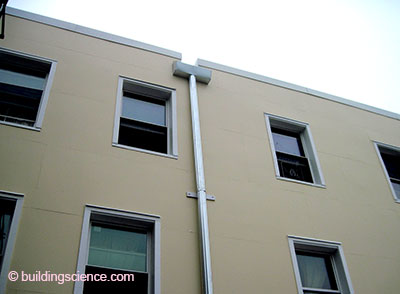
Photograph 11: Scupper Detail – You have to drain the roof.
The big remaining question involves the windows. Are they “innies” or “outies.””? The physics calls for “outies” and that is they way that I push hard for (Figure 4). But lots of folks like the look of “innies” (Photograph 12). With “outies” the thermal control layer of the wall easily lines up with the thermal control layer of the windows. With “innies” this is not the case unless you make the window opening smaller. That reduces glazing area. Good luck with that argument. The best argument for “innies” is that the existing windows are good enough not to be replaced as part of the retrofit. If you are replacing the existing windows with new high performance windows, the best option is an “outie.”
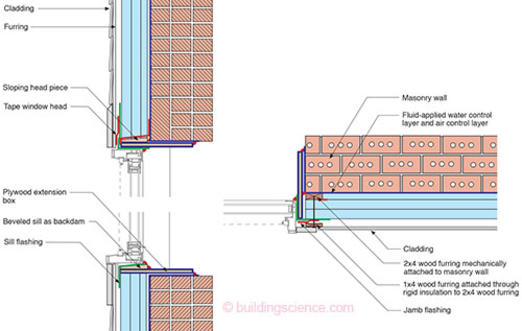
Figure 4: “Outies” - The physics calls for “outies”. With “outies” the thermal control layer of the wall easily lines up with the thermal control layer of the windows.
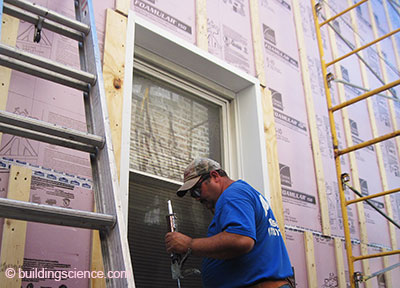
Photograph 12: “Innie” Window—The best argument for “innies” is that the existing windows are good enough not to be replaced as part of the retrofit. If you are replacing the existing windows with new high performance windows the best option is an “outie.”
When you do “outies,” a plywood extension box is used to line the opening, and it protrudes outward past the outward face of the existing masonry to line up flush with the outermost layer of the rigid insulation (Figure 4). The window unit that is installed is typically a flanged window but it is installed with straps that fasten to the interior surfaces of the plywood extension box (Figure 5). Note that the exterior furring straps adjacent to the window openings are not installed until after the flanged window is mounted and “waterproofed.”
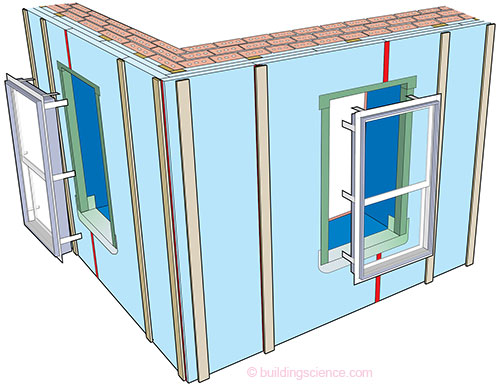
Figure 5: Flanged Window Attachment—When you do “outies,” a plywood extension box is used to line the opening and it protrudes outward past the outward face of the existing masonry to line up flush with the outermost layer of the rigid insulation. A flanged window is installed with straps that fasten to the interior surfaces of the plywood extension box. Note that the exterior furring straps adjacent to the window openings are not installed until after the flanged window is mounted and “waterproofed.”
With house-sized buildings, you also work you way around the sides (Photograph 13). Now it can get weird. Of course, that depends on your definition of weird. In many cases, the exterior insulation only wraps three sides of the four-sided “box.” The “street side” is left undone for “aesthetic” reasons. Some of these houses have interesting looks that are preserved (Photograph 14). Ah, but that leaves a surface uninsulated more or less. Yes, but sometimes “interesting” and “beautiful” trump energy and efficiency. You don’t have to chase every last BTU. Buy a Prius if you want efficiency and ugliness.
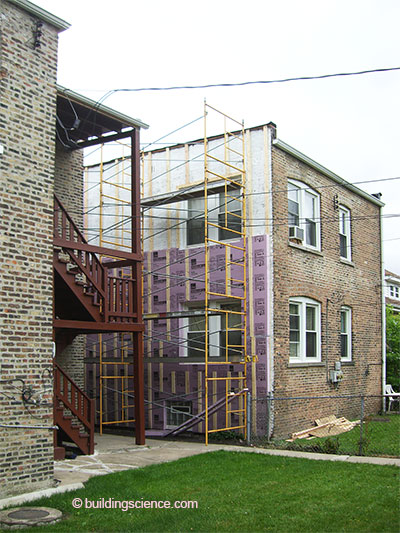
Photograph 13: House-Sized Sequencing—With house-sized buildings you also work you way around the sides.
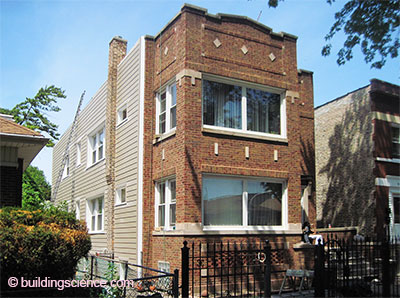
Photograph 14: Finished House Over Clad—In many cases the exterior insulation only wraps three sides of the four sided “box”. The “street side” is left undone for “aesthetic” reasons.
Acknowledgements and References
Stuff happens in Chicago because of good people and they don’t get any better than the folks at the Community and Economic Development Association of Cook County (CEDA). They get the credit for pushing health, safety, comfort, and efficiency in low-income housing. They have one of the best weatherization programs I have ever had the pleasure of working with. A huge “hat tip” goes to John Hamilton, John Yi, Cassandra Fricke, and Scott Sanders, who were at CEDA when the work described here was being developed. The work was supported by the Building America Program, Building Technologies Office, U.S. Department of Energy.
Neuhauser, Ken; “Evaluation of Two CEDA Weatherization Pilot Implementations of an Exterior Insulation and Over Clad Retrofit Strategy for Residential Masonry Buildings in Chicago”, Building America Report – 1311, Building Science Corporation, August 2013.
Footnotes
- Chicago pizza is known as “deep-dish” and made in a pan. I ate way too much of it when I lived there in the late 80’s. Not too many folks know that Chicago pizza was invented by a Longhorn – Ike Sewell. Sewell started Pizzeria Uno in Chicago in the 40’s. Uno is still around. A classic pizza from a Texan? Maybe not. Chicago natives being Chicago natives argue about everything. There is a faction that disputes the Longhorn connection. They claim that Rudy Malnati—he being the original pizza chef at Uno – was the originator. Malnati’s son has a place called Pizano’s serving what is claimed to be the original recipe courtesy of Rudy’s widow Donna Marie who is still alive in her 80’s and romping around the kitchen. I wonder if the Patent and Trademark Office approved the name Pizano’s? I am pretty sure that if the PTO took a run at the Pizano’s name there would be blood in the streets…particularly at the corner of State and Chestnut…I know Chicago and I love Chicago…except when the Blackhawk’s beat my Leafs…oh dear…what will the PTO say about that name? Is it demeaning? Could be…the Leafs have not won since 1967…
- Legend has it that the Windy City got its name from its long-winded politicians and opinionated residents—not from the gusts from Lake Michigan. Carl Sandburg would be chuckling today if he knew that this moniker for his beloved city stuck all these years. Not much has changed with Chicago politicians in the decades since Sandburg was a reporter for the Chicago Daily News except an increase in wind energy due to the use of a teleprompter.
- Note that all of these cities have NHL teams that have won the Stanley Cup since the last time the Toronto Maple Leafs won it, and that most of them have one it more than once.
- Mrs. O’Leary’s cow and the Chicago Great Fire. Note that it really was not Catherine O’Leary’s cow that started the whole thing—we covered that in a footnote a long time ago—but it sure was a good story.
- It helps if you have a fabulous “rock and roll” architect by the name of Chris Benedict living in your city who makes things happen and gets bylaws changed. Ms. Benedict is one of my heroes. Every city needs a Chris. She calmly and rationally pointed out that if you wanted to be green and sustainable and save energy, buildings are going to have to be insulated…and the best place to insulate them is on the outside, and if the buildings are already up you can’t move them farther apart to allow for the insulation thickness…and the folks in NYC got it. It gets even better. If you are building them new, you don’t get penalized either by setbacks when you insulate them on the outside.
